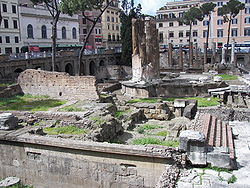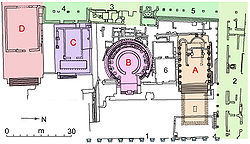
Largo di Torre Argentina
Encyclopedia



Rome
Rome is the capital of Italy and the country's largest and most populated city and comune, with over 2.7 million residents in . The city is located in the central-western portion of the Italian Peninsula, on the Tiber River within the Lazio region of Italy.Rome's history spans two and a half...
, Italy, that hosts four Republican
Roman Republic
The Roman Republic was the period of the ancient Roman civilization where the government operated as a republic. It began with the overthrow of the Roman monarchy, traditionally dated around 508 BC, and its replacement by a government headed by two consuls, elected annually by the citizens and...
Roman temples, and the remains of Pompey's Theatre. It is located in the ancient Campus Martius
Campus Martius
The Campus Martius , was a publicly owned area of ancient Rome about in extent. In the Middle Ages, it was the most populous area of Rome...
.
The name of the square comes from the Torre Argentina, which takes its name from the city of Strasbourg
Strasbourg
Strasbourg is the capital and principal city of the Alsace region in eastern France and is the official seat of the European Parliament. Located close to the border with Germany, it is the capital of the Bas-Rhin département. The city and the region of Alsace are historically German-speaking,...
, whose original name was Argentoratum
Argentoratum
Argentoratum or Argentorate was the ancient name of the French city of Strasbourg.The Romans under Nero Claudius Drusus established a military outpost belonging to the Germania Superior Roman province close to a Gaulish village near the banks of the Rhine, at the current location of Strasbourg,...
. In 1503, in fact, the Papal Master of Ceremonies Johannes Burckardt from Strasbourg built in via del Sudario a palace (now at number 44), called Casa del Burcardo, to which the tower is annexed.
The other tower in the square is not the one giving the name to the place, but the Medieval Torre del Papitto ("Little Pope's Tower"), attributed by tradition to Antipope Anacletus II
Antipope Anacletus II
Anacletus II , born Pietro Pierleoni, was an Antipope who ruled from 1130 to his death, in a schism against the contested, hasty election of Pope Innocent II....
Pierleoni, allegedly not a tall person.
After Italian unification
Italian unification
Italian unification was the political and social movement that agglomerated different states of the Italian peninsula into the single state of Italy in the 19th century...
, it was decided to reconstruct part of Rome (1909), demolishing the zone of Torre Argentina. During the works (1927), however, the colossal head and arms of a marble statue were discovered. The archeological investigation brought to light the presence of a holy area, dating to the Republican era, with four temples and part of Pompey's Theater.
Julius Caesar
Julius Caesar
Gaius Julius Caesar was a Roman general and statesman and a distinguished writer of Latin prose. He played a critical role in the gradual transformation of the Roman Republic into the Roman Empire....
was killed in the Curia
Curia
A curia in early Roman times was a subdivision of the people, i.e. more or less a tribe, and with a metonymy it came to mean also the meeting place where the tribe discussed its affairs...
of the Theatre of Pompey, and the spot he was believed to be assassinated is in the square.
Roman temples
The four temples, originally designated by the letters A, B, C, and D, front onto a paved street, which was reconstructed in the imperial era, after the fire of AD 80. The area was delineated to the North by the Hecatostylum (one-hundred columns porch) and the Baths of AgrippaBaths of Agrippa
The Baths of Agrippa were a structure of ancient Rome, built by Marcus Vipsanius Agrippa, the first of the great thermae constructed in the city. In their first form, constructed at the same time as the Pantheon and on axis with it, as a balaneion , they were apparently a hot-air bath with a cold...
, and to the South by the buildings related to the Circus Flaminius, to the East by the great porched square of Porticus Minucia Frumentaria, and to the West by the Theatre of Pompey.
Temple A was built in the 3rd century BC, and is probably the Temple of Juturna
Juturna
In the myth and religion of ancient Rome, Juturna was a goddess of fountains, wells and springs. She was a sister of Turnus and supported him against Aeneas by giving him his sword after he dropped it in battle, as well as taking him away from the battle when it seemed he would get killed...
built by Gaius Lutatius Catulus
Gaius Lutatius Catulus
Gaius Lutatius Catulus was a Roman statesman and naval commander in the First Punic War.He was elected as a consul in 242 BC, a novus homo. During his consulship he supervised the construction of a new Roman fleet. This fleet was funded by donations from wealthy citizens, since the public treasury...
after his victory
Battle of the Aegates Islands
The Battle of the Aegates Islands or Aegusa was the final naval battle fought between the fleets of Carthage and the Roman Republic during the First Punic War...
against the Carthaginians
Carthage
Carthage , implying it was a 'new Tyre') is a major urban centre that has existed for nearly 3,000 years on the Gulf of Tunis, developing from a Phoenician colony of the 1st millennium BC...
in 241 BC. It was later rebuilt into a church, whose apse is still present.
Temple B, a circular temple with six columns remaining, was built by Quintus Lutatius Catulus
Quintus Lutatius Catulus
Quintus Lutatius Catulus was consul of the Roman Republic in 102 BC, and the leading public figure of the gens Lutatia of the time. His colleague in the consulship was Gaius Marius, but the two feuded and Catulus sided with Sulla in the civil war of 88–87 BC...
in 101 BC to celebrate his victory
Battle of Vercellae
The Battle of Vercellae, or Battle of the Raudine Plain, in 101 BC was the Roman victory of Consul Gaius Marius over the invading Germanic Cimbri tribe near the settlement of Vercellae in Cisalpine Gaul....
over Cimbri; it was Aedes Fortunae Huiusce Diei, a temple devoted to the "Luck of the Current Day". The colossal statue found during excavations and now kept in the Capitoline Museums
Capitoline Museums
The Capitoline Museums are a group of art and archeological museums in Piazza del Campidoglio, on top of the Capitoline Hill in Rome, Italy. The museums are contained in three palazzi surrounding a central trapezoidal piazza in a plan conceived by Michelangelo Buonarroti in 1536 and executed over...
was the statue of the goddess herself. Only the head, the arms, and the legs were of marble: the other parts, covered by the dress, were of bronze.
Temple C is the most ancient of the three, dating back to 4th or 3rd century BC, and was probably devoted to Feronia the ancient Italic
Ancient Italic peoples
Ancient people of Italy are all those people that lived in Italy before the Roman domination.Not all of these various people are linguistically or ethnically closely related...
goddess of fertility. After the fire of 80 AD, this temple was restored, and the white and black mosaic of the inner temple cell dates back to this restoration.
Temple D is the largest of the four, dates back to 2nd century BC with Late Republican restorations, and was devoted to Lares
Lares
Lares , archaically Lases, were guardian deities in ancient Roman religion. Their origin is uncertain; they may have been guardians of the hearth, fields, boundaries or fruitfulness, hero-ancestors, or an amalgam of these....
Permarini
Lares Permarini
Lares Permarini was a Roman temple , of the Lares who protect sailors, in the campus Martius.It was vowed by the praetor, L. Aemilius Regillus, while engaged in a naval battle with the fleet of Antiochus the Great in 190 B.C., and dedicated by M. Aemilius Lepidus, when censor, on 22 December, 179....
, but only a small part of it has been excavated (a street covers the most of it).
18th century opera house
The Teatro ArgentinaTeatro Argentina
The Teatro Argentina is an opera house and theatre located in the Largo di Torre Argentina, a square in Rome, Italy. It is one of the oldest theatres in Rome, and was inaugurated on January 31, 1732 with Berenice by Domenico Sarro....
is an 18th century opera house
Opera house
An opera house is a theatre building used for opera performances that consists of a stage, an orchestra pit, audience seating, and backstage facilities for costumes and set building...
and theater located in the square. The premieres of many notable operas took place there. They include Gioachino Rossini's The Barber of Seville
The Barber of Seville
The Barber of Seville, or The Futile Precaution is an opera buffa in two acts by Gioachino Rossini with a libretto by Cesare Sterbini. The libretto was based on Pierre Beaumarchais's comedy Le Barbier de Séville , which was originally an opéra comique, or a mixture of spoken play with music...
in 1816 and Giuseppe Verdi
Giuseppe Verdi
Giuseppe Fortunino Francesco Verdi was an Italian Romantic composer, mainly of opera. He was one of the most influential composers of the 19th century...
's I due Foscari
I due Foscari
I due Foscari is an opera in three acts by Giuseppe Verdi to an Italian libretto by Francesco Maria Piave, based on a historical play, The Two Foscari by Lord Byron....
in 1844 and La battaglia di Legnano
La battaglia di Legnano
La battaglia di Legnano is an opera in four acts, with music by Giuseppe Verdi to an Italian-language libretto by Salvadore Cammarano. It was based on the play La Bataille de Toulouse by Joseph Méry. The opera received its first performance on 27 January 1849, at the Teatro Argentina, Rome...
in 1849.
The cat shelter
Located in Largo Argentina is the Torre Argentina Cat Sanctuary, a no-kill shelterNo-kill Shelter
A kill shelter is an animal shelter where animals are euthanized if they are too sick to be treated or too aggressive to be suitable for adoption or due to lack of shelter space...
for homeless cats (of which Rome has many), as the historical area abounds with various breeds of cats.

